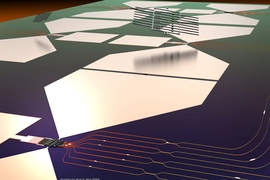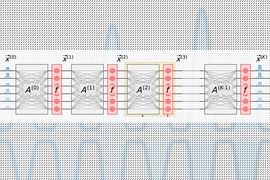In the universe, there is the world we can see with the naked eye: trees, planes in the sky, dishes in the sink. But there are other worlds that reveal themselves with the help of a magnifying glass, telescope, or microscope. With these, we can see up into the universe or down into the smallest particles that make it up. The smallest of these is a world populated by particles smaller than an atom: the quantum world.
Physicists who probe this world study how these subatomic particles interact with one another, often in ways not predicted by behavior at the atomic or molecular level. One such physicist is Nicholas Rivera, who studies light-matter interactions at the quantum level.
Unfinished business
In the quantum world, light is two things: both a wave and a small particle called a photon. “I was always fascinated with light, especially the quantum nature of light,” says Rivera, a Department of Physics graduate student in Professor Marin Soljačić’s group.
According to Rivera, there is still a lot we don’t know about quantum light, and uncovering these unknowns may prove useful for a number of applications. “It’s connected to a lot of interesting problems,” says Rivera, such as how to make better quantum computers and lasers at new frequencies like ultraviolet and X-ray. It’s this dual nature of the work — with fundamental questions coupled with practical solutions — that attracted Rivera to his current area of research.
Rivera joined Soljačić’s group in 2013, when he was an undergraduate at MIT. Since then his research has focused on how light and matter interact at the most elementary level, between quanta of light, also called photons, and electrons of matter. These interactions are governed by the laws of quantum electrodynamics and involve the emission of photons by electrons that hop up and down energy levels. This may sound simple, but it is surprisingly difficult because light and matter are operating on two different size scales, which often means these interactions are inefficient. One specific goal of Rivera’s work is to improve that efficiency.
“The atom is this tiny thing, a 10th of a nanometer large,” says Rivera. But when light takes the form of a wave, its wavelengths are much larger than an atom. “The idea is that, because of this mismatch, many of the possible ways that an electron could release a photon are just too slow to be observable.” Rivera uses theory to figure out how light and matter could be manipulated to allow for new types of interactions and ways to intentionally change the quantum state of light.
Inefficient interactions are often thought of as “forbidden” because, in normal circumstances, they would take billions of years to happen. “The forbidden light-matter interactions project is something we have been thinking about for many years, but we didn’t have a suitable material-system platform for it,” says Soljačić. In 2015, graphene plasmons arrived on the scene, and forbidden interactions could be explored.
Graphene is an ultra-thin 2D material, and plasmons are another quantum-scale particle related to the oscillation of electrons. In these ultra-thin materials, light can be “shrunk” so that the wavelengths are closer to the scale of the electrons, making forbidden interactions possible.
Rivera’s first paper on this topic, published the summer after he graduated with his bachelor’s degree in 2016, was the start of his longstanding collaboration with Ido Kaminer, an assistant professor at the Technion-Israel Institute of Technology. But Rivera wasn’t done with light-matter interactions. “There were so many other directions that one could go with that work, and I really wanted the ability to probe all of them,” Rivera says, and he decided to stay in Soljačić’s group for his PhD.
A natural match
That first collaboration with Kaminer, who was then a postdoc in Soljačić’s group, was a pivotal moment in Rivera’s career as a physicist. “I was working on a different project with Marin, but then he invited me to his office with Ido and told me about the project that would become the 2016 paper,” says Rivera. According to Soljačić, putting Kaminer and Rivera together “was a natural match.”
Kaminer moved to the Technion in 2018, which was when Rivera took his first trip to Haifa, Israel, with funds provided by MISTI-Israel, a program within the MIT International Science and Technology Initiatives (MISTI). There, he gave a seminar and met with students and professors. “That visit seeded some projects that we’re still working on today,” says Rivera, such as a project where vacuum forces were used to generate X-ray photons.
With the help of lasers and optical materials, it’s relatively easy to generate photons of visible light, but making X-ray photons is much harder. “We don’t have lasers the same way we do for visible light, and we don’t have as many materials to manipulate X-rays,” says Rivera. The search for new strategies for generating X-ray photons is important, Rivera says, because these photons can help scientists explore physics at the atomic scale.
This past January, Rivera visited Israel for the third time. On these trips, “[we make] progress on the collaborations we have with the students, and also brainstorm new projects,” says Rivera. According to Kaminer, the in-person brainstorming is vital when coming up with new ideas. “Such creative ideas are, in the end, the most important part of our work as scientists,” Kaminer explains. During each visit, Rivera and Kaminer sketch out a research plan for the next six months to year, such as continuing to investigate new ways to control and generate quantum sources of X-ray photons.
When investigating the theory of light-matter interactions, the potential applications are never far from Rivera’s mind. “We’re trying to think about applications that could potentially be realized next year and in the next five years, but even potentially further down the line.”
For Rivera, being able to be in the same place as his collaborators is a major boon, and he doubts the continued collaboration with Kaminer would be as active if he hadn’t taken that first trip to Haifa in 2018. “And the hummus isn’t bad,” he jokes.
When Soljačić introduced Rivera and Kaminer five years ago, neither expected that the collaboration would still be going strong. “It’s hard to anticipate what collaborations will be successful in the long term,” says Kaminer. “But more important than the collaboration is the friendship,” he adds.
The deeper Rivera explores the quantum aspects of light-matter interactions, the more potential avenues of exploration open up. “It just keeps branching,” says Rivera. And he envisions himself continuing to visit Kaminer in Israel, no matter where his research takes him next. “It’s a lifelong collaboration at this point.”











